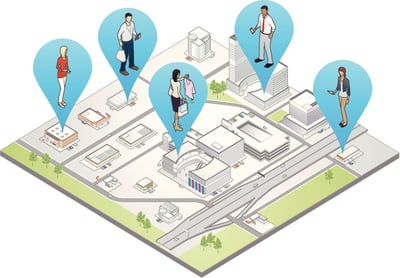February 24, 2023
![]() by Sharat Potharaju / February 24, 2023
by Sharat Potharaju / February 24, 2023

Marketers often view the online and offline worlds as separate entities that require different strategies.
However, you can achieve higher conversion rates and return on investment (ROI) by adopting a holistic strategy and synchronizing online and offline marketing efforts.
Today's shoppers have become hybrid and constantly move between physical and digital shopping. They expect consistent interactions across all channels. QR codes play a critical role in bridging this gap by enabling brands and marketers to seamlessly transition between physical and digital experiences.
By simply scanning a QR code with a smartphone, consumers can be directed to a website, get additional information, or access special promotions. This technology gives marketers a quick and easy way to connect with consumers and drive engagement.
QR codes enable brands to improve the shopping experience, collect valuable data and insights, and ultimately increase sales. In short, QR codes are a crucial tool for marketers to stay on top of an ever-evolving digital landscape and deliver the seamless, hybrid experiences that modern consumers demand.
Your customers shouldn’t have to type, tap, or search—just scan! Whether you’re sharing a menu, a promo, or a business card, don’t settle for clunky generators. Find the best QR code generators to create smooth, scannable experiences.
QR codes have been around for almost 30 years. The technology, first used to track components in car factories, has evolved into a highly effective marketing tool. QR codes streamline the shopping journey by enabling marketing teams to direct and control customer interactions with their brand.
Other benefits of implementing QR codes include:
Now that you understand the benefits see how QR code technology fits into the martech stack.
Curious how brands are using QR codes? These QR code statistics offer a strategic snapshot of what’s working for them.
Successful marketing funnels enable sales and marketing teams to deliver relevant information to the right people at the right time across all channels. QR codes help identify what prospects already know, what information they still need, and how interested they are in your products or services. This allows you to integrate the technology at every stage.
A strong presence ensures your brand stays in the minds of your consumers, so focus on building brand awareness first. But "brand awareness" is a bit vague, and marketers often struggle to measure brand awareness compared to tracking a sale or conversion. This challenge presents a great use case for QR codes.
QR codes increase brand awareness by connecting customers to your company's website, landing pages, and social media accounts. A QR code invites customers to engage with your brand immediately. Meanwhile, it also helps marketers track engagement rates and optimize their campaigns based on aggregative insights like the number and location of scans.
The next step in the marketing funnel is generating relevant leads. Successful lead generation yields larger customer bases and higher sales. Generate high-quality leads using QR codes to direct customers to contact forms, information requests, special promotions, and email lists. This helps you effectively present your products and services to potential customers and attract the right audience.
Brands don't typically move directly from lead generation to lead conversion. Leads need nurturing. In fact, companies that excel at lead nurturing generate 50% more sales.
Place QR codes on products to retarget prospects by providing more product information or initiating app downloads. You can also integrate leads from QR code campaigns with email marketing solutions to schedule and send follow-up messages.
The final stage of the marketing funnel generates revenue and fosters brand loyalty. Businesses expect efforts to generate and nurture inspire desired conversion actions, such as buying a plan or product, filling out a form, or signing up for a demo.
Implementing QR codes at this stage for linking to customer testimonials, product demo signups, and customer feedback surveys enhances the customer experience. A quick QR code scan can also direct customers to a how-to video. This value-added content allows customers to learn more about your product or service and make smarter (and faster) purchasing decisions.
Check out these popular applications if you haven't already used QR codes for marketing.
While almost 80% of all physical business cards end up in the trash within the first week of receipt, they can (and do) play an essential role in creating brand awareness and perception. In today's digital world, you need to adopt contactless solutions. For example, a digital business card (DBC) offers a more secure, engaging, and effective way to stand out among competitors.
The DBC market is estimated to reach $242.3 million by 2027. Yet, 77% of people don’t use this technology. Brands using DBCs will be one step ahead when offering customers a unique, seamless omnichannel experience.
All you need is a business card with a QR code for someone to retrieve your contact information and save it to their mobile devices. Another option? Include a DBC in your email signature, social media posts, or physical collateral.
Nearly 75% of consumers research products in-store on a mobile device. Capitalize on this habit by adding QR codes to product packaging. This strategy improves the customer experience by allowing shoppers to access relevant product information such as manufacturing processes, the origin of products or ingredients, and logistics.
This information, which wouldn’t normally fit on your label, is critical to consumers. Sharing creates transparency and builds trust. Most consumers (94%) are loyal to brands committed to full transparency.
Smart product packaging also helps you collect first-party data. Currently, more than 81% of businesses rely on third-party data, even though 85% of customers want brands to only use first-party data. Retailers have to change quickly. Firefox and Safari web browsers blocked access to third-party cookies, and Google Chrome will do the same in 2023.
Businesses typically source data from third-party retailers at their discretion or research firms in aggregate. However, neither option allows brands to establish direct customer relationships.
Shifting your focus to first-party data improves personalization and nurtures customer relationships. Use a product QR code to request email addresses and phone numbers to send personalized coupons, offers, and other relevant targeted messaging.
Printed materials like billboards, flyers, receipts, and brochures are still valuable despite a major shift to digital marketing. Printed collateral quickly grabs attention. However, making changes to them takes time and resources.
Inserting a dynamic QR code solves this problem, as you can edit them at their source (and at no extra cost). Dynamic QR codes also allow interested parties to connect with your brand and facilitate data sharing. The data from each scan can further inform your future campaign development.
Dynamic QR codes don't just help brands update their messaging. This technology also supports 24/7 availability, so customers can conveniently get the information they need to make decisions. For example, a customer can scan a dynamic QR code on a poster to get up-to-date information, such as information about a venue or a time change due to bad weather.
You can easily edit dynamic QR codes to give customers a new address without reprinting all the flyers at the last minute. Then, the customers can decide whether they want to attend the event. Providing customers with choice and decision support drives brand loyalty and trust.
Your digital marketing strategy needs social media to connect with consumers in the digital age. More than half of the world's population uses social media, and the average user interacts across six platforms.
But how do you use QR codes to enhance your social media marketing strategy?
Add the codes to posters, products, and packaging when sharing on social media. As you attract more visitors to your network, your business gains more subscribers, likes, and shares. Explore different QR code types, too.
Some QR types:
If you want to direct your customers to multiple destinations, provide an all-in-one QR code that links to a landing page with all the options available. Customers choose the content they want to see before making it to their final destination.
Over 87% of US households have at least one internet-connected TV, and more than 70% prefer free ad-supported content to paid, ad-free content. The rise of streaming content offers brands greater opportunities to reach the right audiences.
Connected TV (CTV) advertising combines the reach of traditional TV ads with the precision of digital marketing channels. However, even the smartest ads still can't nudge an immersed viewer into action, which deviates from your ideal conversion numbers.
Many ads rely on one-way communication to pique people’s interest. A call-to-action can be the solution here and will help you get a higher response.
QR codes provide a convenient, seamless touchpoint to engage your audience. Since 88% of Americans use a second screen – like a smartphone – while watching TV, it’s easy to scan once they see a CTV ad with a QR code. App download QR codes, for example, take viewers from their TV screen to the App Store.
There are no limits to using QR codes for marketing. You can easily experiment with other ways of using QR codes that suit your needs.
Consider these tips if you're new to using QR codes or ready to embed them in your marketing campaigns.
Like any other marketing channel, QR codes require testing and fine-tuning. Brands that nail their QR code usage unearth a high-converting way to build long-lasting customer relationships. More than 83.4 million US smartphone users scanned a QR code on their mobile devices in 2022; by 2025, this number is expected to reach 99.5 million.
In a world where smartphones dominate, you can't afford to miss out on this marketing reach, so make smartphones with QR codes your marketing partner.
Before you use a QR code, learn how to protect your valuable information from cyber threats and ensure QR code security.
Sharat Potharaju is the Co-founder and CEO of Beaconstac. He's dedicated to achieving Beaconstac’s vision of enabling digital connection with every physical object and place on the planet. Sharat holds an MS in engineering management from Duke University and a BS in engineering from the Indian Institute of Technology (IIT) Madras.
Brands and marketers try to base entire strategies around this one age-old question: what do...
 by Sneh Choudhary
by Sneh Choudhary
Marketing, as always, is constantly evolving.
 by Vyshnavi Basuthkar
by Vyshnavi Basuthkar
As a content marketer, I am sure you would have never had it easy.
 by Victoria Taylor
by Victoria Taylor
Brands and marketers try to base entire strategies around this one age-old question: what do...
 by Sneh Choudhary
by Sneh Choudhary
Marketing, as always, is constantly evolving.
 by Vyshnavi Basuthkar
by Vyshnavi Basuthkar


